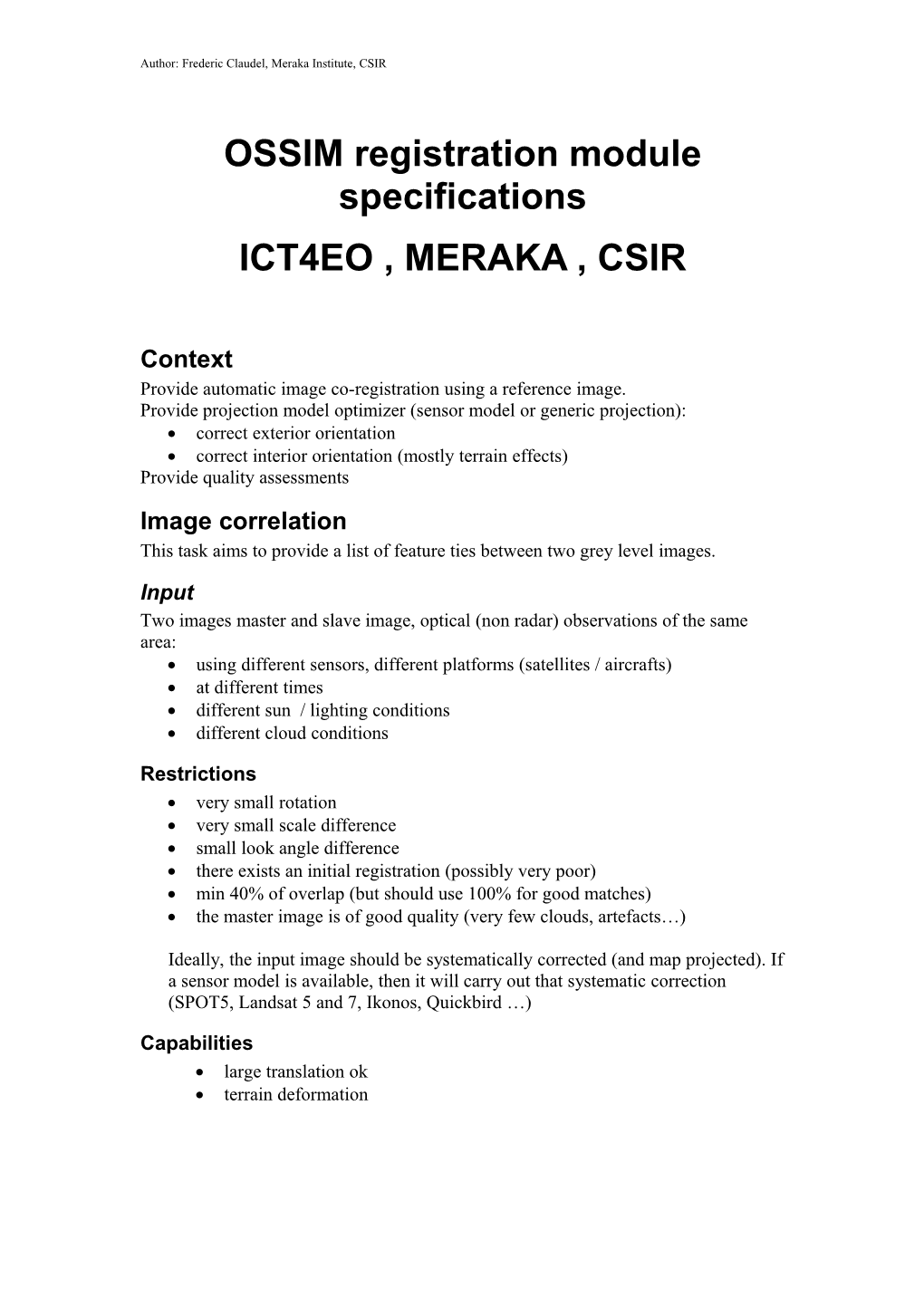Author: Frederic Claudel, Meraka Institute, CSIR
OSSIM registrationmodule specifications
ICT4EO , MERAKA , CSIR
Context
Provide automatic image co-registration using a reference image.
Provide projection model optimizer (sensor model or generic projection):
- correct exterior orientation
- correct interior orientation (mostly terrain effects)
Provide quality assessments
Image correlation
This task aims to provide a list of feature ties between two grey level images.
Input
Two images master and slave image, optical (non radar) observations of the same area:
- using different sensors, different platforms (satellites / aircrafts)
- at different times
- different sun / lighting conditions
- different cloud conditions
Restrictions
- very small rotation
- very small scale difference
- small look angle difference
- there exists an initial registration (possibly very poor)
- min 40% of overlap (but should use 100% for good matches)
- the master image is of good quality (very few clouds, artefacts…)
Ideally, the input image should be systematically corrected (and map projected). If a sensor model is available, then it will carry out that systematic correction (SPOT5, Landsat 5 and 7, Ikonos, Quickbird …)
Capabilities
- large translation ok
- terrain deformation
Note
- When possible (sensor model) the elevation mapis used for correlation. Unfortunately, in case of a large input image position inaccuracy, the elevation might induce errors.
Output
Provides a large list of tie points between master and slave, either
- in memory
- XML/GML file
- tabulated text file
It contains the accuracy values of ground and image points.
Atie point connects:
- a corner feature in the master image (ground point, WGS84, height above geoid)
- the corresponding feature in the slave image (pixels)
A connection probability is also provided (value between -1 and 1, 1 meaning perfect match)
Method
Parameters
image bands to use for master and slave
common projection to use (master or slave projection)
scaling factor (between 0 and 1)
absolute accuracy between images (in pixels)
maximum density of corner points
minimum NCC to consider
master chip image radius (pixels)
Procedure
The correlation is established at a specific scale. The images might have to be downsized (using OSSIM overviews).
Corners are detected in the master image using Harris corners. The corners are spread uniformly on the master image.
For each corner:
- An image chip is extracted around the corner in the master image (using a user defined radius)
- A slave image chip is extracted around the corner position in the slave image (obtained using the initial registration). A larger radius is used (master radius + absolute accuracy)
- Normalized Cross Correlation between master and slave image chips is computed.
- A tie point connection is established whenNCC is above the minimum threshold.
- Sub-pixel accuracy is possible when the NCC map is concave.
Note
The resulting image tie point positions can be projected on the ground
Outlier rejection is not performed here
Number of tie points can be very important (maximum tie point density is usually around 10^-3 pixels^-2, which means 100.000 tie points for a 7000x7000 pixel Landsat 5 scene)
Post-processing: needs outlier rejection (few outliers).
Model optimization
This task will optimize sensor projection models or create optimized generic projection models, using tie points as a reference.
Input
A set of tie points (between the ground truth and the input image)
A model type
Required model/projection information:
- Preferred direction of projection: most projections are defined in one direction only, from ground to image or from image to ground, and the reverse function is obtained by iterated convergence, so projection model shall indicate which direction will be used for optimization.
- Initial state for non linear models (like sensor models)
- Optional Parameters (e.g. exponent list for polynomial projection)
- Specific optimization function
- The number of degrees of freedom for the model
Output
Optimized model, exported via a geometry file
RMS value for the fit
Method
The optimization method depends on each specific projection model.
Linear models (bilinear, polynomial) can be optimized quickly using the least mean squares method.
Non linear models (including parameterized sensor models) will be optimized with the Levenberg-Marquardt algorithm (iterative method).
Notes:
Non-linear methods are usually slow, and will be penalized if a large number of tie points are used
Model Optimization with outlier rejection
That task will optimize models as in the previous section, but will try to remove outlier tie points (or select inliers) before the final optimization is carried out.
Input
Inputs as for the Model Optimization (see above).
An inlier ratio estimate
An error estimate for a good fit
Output
Output from Model Optimization
An inliers tie point set (subset of input set).
Final inlier ratio
RMS value for the fit
Method
RANSAC is used to select a correct fit (enough inliers within a certain distance of a model):
A model is initialized with (optimized using) a minimum number of randomly chosen tie points. If the model fits with a large enough tie points set (above the inlier ratio, and within the given error threshold), then the inlier set is used for a final optimization.
That process is repeated a certain number of times, calculated from the inlier ratio and the number of degrees of freedom.
Notes:
We can expect a good amount of outliers when using automatic feature matching.
Models with a large number of parameters will require a long time to provide a good candidate.
